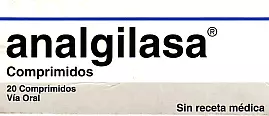Online Pharmacy & Drugstore
|
 |
| Home Terms and Conditions FAQ Newslist Testimonials Affiliate Support Link Exchange |
| Allergy Relief | Antibiotics | Anti Depression | Muscle relaxants | Men´s health | ||
| Pain Relief | Sedatives | Sleep | Weight Loss | Women´s Health | Other |
Analgilasa (Codeine / Caffeine) additional information
Common usesCodeine phosphate, obtained from opium or prepared from morphine by methylation, is a centrally acting analgesic used for the relief of mild to moderately severe pain.Codeine is used as an analgesic, a cough suppressant, or a sedative / hypnotic drug. The phosphate of the alkaloid codeine is used because of its free solubility in water.
DirectionsAnalgilasa codeine with caffeine comes as a tablet containing 10 mg. codeine, 500 mg. paracetamol and 30 mg. caffeine, to take by mouth.Individual dosing requirements vary considerably based on each patient's age, weight, severity and cause of pain, and medical and analgesic history. Following successful relief of pain, periodic attempts to reduce the opioid dose should be made. Normal adult dose is one-two tablet every six-twelve hours when needed. Do not take more than five tablets during any 24-hour period. If you miss a dose, take it as soon as remembered if it is within an hour or so. If you do not remember until later, skip the missed dose and resume your usual dosing schedule. Do not "double-up" the dose to catch up.
PrecautionsCodeine should not be used by individuals with hypersensitivity to opioid analgesics, acute asthma or other obstructive airway disease and acute respiratory depression, cor pulmonale, acute alcoholism, delirium tremens, severe CNS depression, convulsive disorders, increased cerebrospinal or intracranial pressure, head injury, suspected surgical abdomen, concomitant MAO inhibitors (or within 14 days of such therapy).Codeine should be used with extreme caution in patients with substantially decreased respiratory reserve, pre-existing respiratory depression, hypoxia or hypercapnia. Codeine administration may result in severe hypotension in individuals whose ability to maintain adequate blood pressure is compromised by reduced blood volume, or concurrent administration of such drugs as phenothiazines or certain anesthetics. Codeine should be administered with caution, and in reduced dosages, to elderly or debilitated patients, to individuals with severely reduced hepatic or renal function, and in individuals with Addison's disease, hypothyroidism, prostatic hypertrophy or urethral stricture. Codeine may impair the mental and/or physical abilities needed for certain potentially hazardous activities such as driving a car or operating machinery. Patients should be cautioned accordingly. Codeine should be used only when clearly needed during pregnancy. Discuss the risks and benefits with your doctor. Codeine is excreted into breast milk. Consult your doctor before breast-feeding. The analgesic effect of codeine is potentiated by amphetamines, chlorpromazine and methocarbamol. CNS depressants, such as other opioids, anesthetics, sedatives, hypnotics, barbiturates, phenothiazines, chloral hydrate and glutethimide may enhance the depressant effects of codeine. MAO inhibitors, pyrazolidone antihistamines, beta-blockers and alcohol may also enhance the depressant effect of codeine. When combined therapy is contemplated, the dose of one or both agents should be reduced.
Possible side effectsThe most frequently observed side effects of opioid analgesics such as codeine are sedation, nausea and vomiting, constipation, lightheadedness, dizziness, and sweating.Less frequent side effects include dysphoria, euphoria, weakness, headache, agitation, tremor, uncoordinated muscle movements, alterations of mood, muscle rigidity, paresthesia, muscle tremor, blurred vision, nystagmus, diplopia and miosis, transient hallucinations and disorientation, visual disturbances, insomnia and increased intracranial pressure may occur. If you notice other effects not listed above, contact your doctor.
OverdoseIf overdose of codeine is suspected, contact your local poison control center or emergency room immediately. Serious overdosage with opioids may be characterized by respiratory depression, extreme somnolence progressing to stupor or coma, skeletal muscle flaccidity, cold and clammy skin, and sometimes bradycardia and hypotension. In severe overdosage, apnea, circulatory collapse, cardiac arrest and death may occur
Additional informationKeep codeine in a tightly closed container and out of reach of children. Store codeine at room temperature and away from excess heat and moisture (not in the bathroom).Physical dependence with or without psychological dependence tends to occur on chronic administration of opioids such as codeine. The following withdrawal symptoms may be observed after opioids are discontinued: body aches, diarrhea, gooseflesh, loss of appetite, nervousness or restlessness, runny nose, sneezing, tremors or shivering, stomach cramps, nausea, trouble with sleeping, unusual increase in sweating and yawning, weakness, tachycardia and unexplained fever. Individuals who are appropriately treated with opioid analgesics and who undergo gradual withdrawal from codeine, these symptoms are usually mild.
NoteThe above information is intended to supplement, not substitute for, the expertise and judgment of your physician, or other healthcare professional. It should not be construed to indicate that use of codeine is safe, appropriate, or effective for you. Consult your health care professional before you buy Analgilasa (Codeine / Caffeine).
|
|